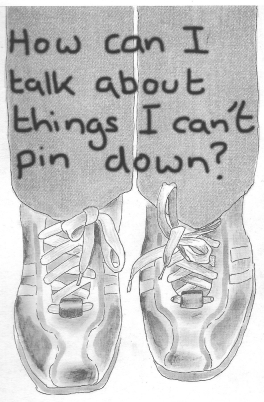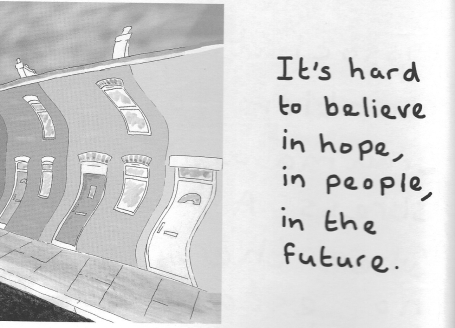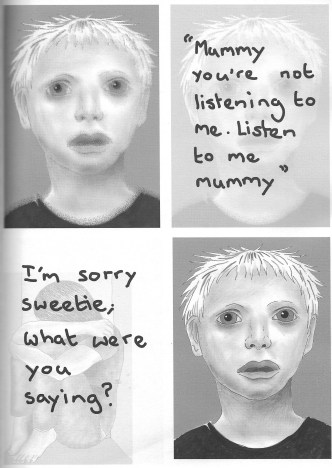In her new book Not My Shame, T.O. Walker tells a story that I can really relate to. Published in the U.K. in 2017 by Singing Dragon, Not My Shame is a graphic memoir about assault, hard-earned survival, and the redemption of human connection. The non-linear narrative reflects the experiences of an assault survivor living her current life as a parent, partner, and professional while managing the imposing presence of traumatic events long past.

Particularly strong and relatable is Walker’s illustration of the challenge of being a loving parent even during the most haunting moments of trauma recovery, and the tremendous healing power of family connections. She handles gracefully the nearly indescribable experiences of flashbacks, dissociation, and intrusive memories that are at once foggy and piercing.
This 72-page memoir shows the author discovering her artistic and political voice in telling her own story and in spotlighting rape culture, anti-Islamic protests under the guise of protecting children, and failings of social services and mental health providers. Ultimately hopeful, Not My Shame is a challenge to read because of the topic and the style in which it is presented. My first reading told me that there was an important story to be revealed, and my second reading unveiled a nuanced telling of the author’s experiences, often abstract but nonetheless cohesive.
I’d like to thank T.O. Walker for answering some questions by email about the making of the book and the experience of publishing a very personal story.
Would you please give a brief description of your book?
Not My Shame is a hopeful graphic novel about being a survivor. It’s is based on my experiences of sexual violence, my personal responses to this and the responses of others including peers, police, and health services. It looks at victim blaming, racism and the media, and it shares my love of people close to me, creativity and activism.
How did the comics/graphic novel medium impact how you told this story?
Using this medium enabled me to both show and tell my story at the same time; it enabled me to immerse the reader in parts of my experience and emotions, but to also have a voice and comment on the experiences I was sharing. I like the way this combination creates immediate emotional impact and encourages thought and reflection.
The graphic novel medium also lent itself well to distorting time and perception, this was really useful in creating a narrative about trauma, which itself can impact on our perceptions of the world around us and how we experience time.
Because images can be so powerful it was a challenge to create images that communicated the information and emotions I wanted to communicate but were also sensitive and not overly graphic. I hope I have managed to do this.

Please tell me about the materials you used to create the work. There are elements of photo collage, pen and ink illustration, and distortion of repeated images. What was the process of choosing this style?
I began by drawing and painting pen and ink illustrations, which was initially just for myself, to express aspects of my experience. I find painting a great way to communicate and express emotion.
I wanted to remind readers that this is reality for many people, which is where the photo collage came in…
After a while I found I had very many of these illustrations and decided that I wanted to create a book from them for others to read. It felt important that these illustrations were in context and I wanted to remind readers that this is reality for many people, which is where the photo collage came in, including photos I took of media headlines, scans of my medical notes and photos from inside my home.
The repeated and distorted images came towards the end of the process as I put the book together. I found creating a narrative from the images I had a challenge as I wanted readers to get a sense of how trauma can make time feel nonlinear, repeated and distorted images felt like a good way to do this.

One central theme of the story is the importance of being present in relationships. You write, “If we disconnect from ourselves and our experiences then we disconnect from others.” Have you found that the process of creating the book has connected you with others?
The publication of Not My Shame has directly created moments of connection between me and people who have read it. More importantly, for me it has created better connection between different parts of myself, my past and my present, which in turn has enabled me to connect more deeply and more openly with people who are important to me. I guess partly publishing it was a process of trying to let go of feelings of shame; when we feel ashamed we hide, when we no longer feel ashamed we stand where we can be seen and so are better able to connect with others.
The experience of flashbacks and dissociation is an important aspect of this story, and is a particularly difficult experience to communicate. How did you approach that topic in your art?
As mentioned I used repeated and disordered images to portray some of the elements of flashbacks. Not My Shame is somewhat of a chaos narrative with snapshots of moments in time that are jarring and disorientating, in much the same way that flashbacks can be. I wanted readers to get a feel of what it can be like.
Not My Shame is somewhat of a chaos narrative with snapshots of moments in time that are jarring and disorientating, in much the same way that flashbacks can be.
In terms of dissociation it felt important to make use of blank spaces and have images that were ‘foggy’ to illustrate the sense of blankness, distance and disconnection that comes with dissociation. It also felt important to contrast this with images of strong connection, like positive images of myself with my child, partner and friends.

As the book progresses, the narrator becomes increasingly engaged in child abuse awareness and political action. Could you tell me more about that experience?
I think activism can be very healing and promote a sense of connection with the world, as well being a positive way to increase awareness about things like sexual violence and gender based violence. I have been involved in political activism to varying degrees at different times, I have a strong sense of justice and I see activism as a productive use of righteous anger!
I would like to see a legal system which better serves the needs of victims and specialised trauma focused services available for all survivors. So many people are affected and society has a long way to go in terms of preventing victim blaming, and increasing knowledge and understanding of grooming and trauma.
Writing about such emotionally difficult stories can be very heavy! What kind of support and self-care did you seek out while you were working on the book?
I have a very supportive partner and friends but I didn’t feel I needed particular support during the process of creating Not My Shame. I had a very difficult time not long before I started creating the book and during that time I accessed therapy and made a conscious effort to do lots of self-care, which for me involved running outdoors, time with people I care about, painting, activism and baking bread!
The process of creating Not My Shame was the next step; it was a very cathartic process and felt therapeutic.
Please tell me about working with your publisher. How did you establish that relationship, and what was the process of publishing like?
To be honest I just contacted them with a pretty much completed book. They got back in touch with me via Twitter and have been positive, supportive and encouraging. Until I sent it to my publisher I hadn’t shown the whole book to anyone which was probably foolish and made it feel like a very big deal.
There were a minor changes I had to make (apostrophes are my downfalldown fall!) but Singing Dragon didn’t ask me to make any big changes, which was really important to me as it was so personal and I wanted to feel ownership of it. The process was quicker than I expected and when the book came out I felt a mixture of vulnerability and pride.
You write very tenderly about your relationships with your son and your partner. How has being a parent influenced your desire to tell your story, or the way you have chosen to tell your story?
Being a parent has amplified my affection for children generally and my drive to do anything I can to help prevent abuse of children, or to support those who have been abused. It has made me more understanding of what my own needs were as a child and my own actions, which has made me kinder to myself and influenced how I framed my story.
The presence of my partner and son, in my life and in the book, are signs of both love and hope, to me the connection of love is the antithesis of hurt and trauma.
Is there is anything more you’d like to say about your experiences as an assault survivor? I mean this to be very open ended, and in the spirit of supporting other survivors — please share anything you want to.
It has been hard work and there were times when I felt like giving up. I’m glad I didn’t give up. Realising I am not alone has been a very important step, as was understanding that I was not to blame for what was done to me, or my reactions to it. Feminism, friends and therapy were all very important to my journey too, I feel very appreciative of them.
